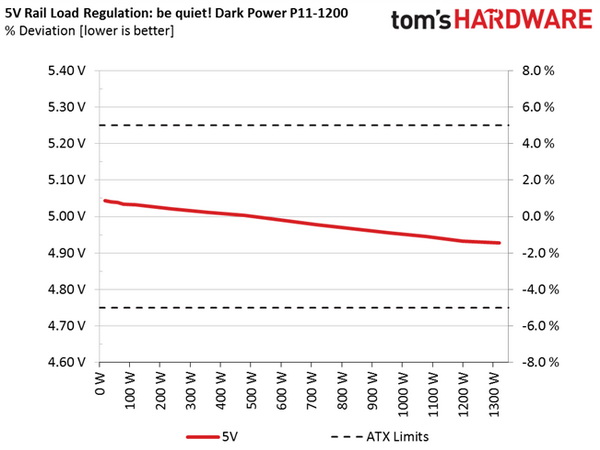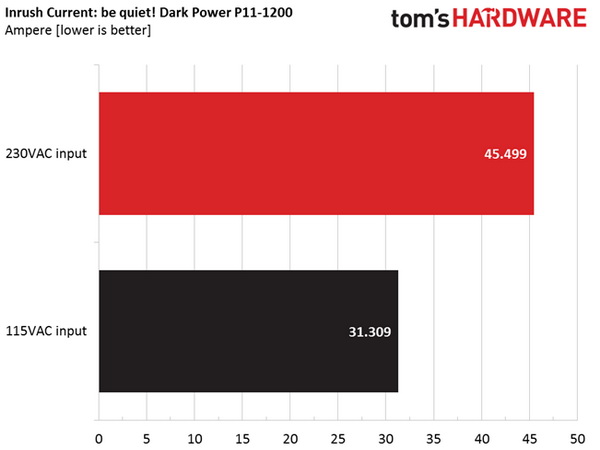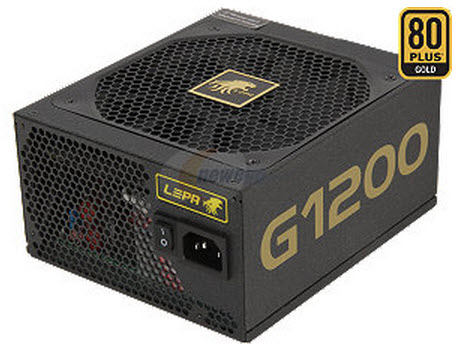Be Quiet! Dark Power Pro 11 1200W PSU Review
be quiet! says it's committed to building silent products, including the company's top PSU line, the Dark Power Pro 11. In this review, we will put the 1200 W Dark Power Pro 11 model to the test, which promises good performance and silent operation.
Why you can trust Tom's Hardware
Load Regulation, Hold-Up Time And Inrush Current
To learn more about our PSU tests and methodology, please check out How We Test Power Supply Units.
Primary Rails And 5VSB Load Regulation
Load Regulation testing is detailed here.








Hold-Up Time
Our hold-up time tests are described in detail here.


The hold-up time that our equipment measured was lower than 16 ms, so the PSU failed in this test.
Inrush Current
For details on our inrush current testing, please click here.


The registered inrush current was adequate, especially for a 1.2 kW unit. This is great news, but we would prefer to see a little higher inrush current, which could be possible if be quiet! used higher capacity hold-up caps, instead of a hold-up time lower than 16 ms.
Load Regulation And Efficiency Measurements
The first set of tests reveals the stability of the voltage rails and the PSU's efficiency. The applied load equals (approximately) 10 to 110 percent of the maximum load the supply can handle, in increments of 10 percentage points.
Get Tom's Hardware's best news and in-depth reviews, straight to your inbox.
We conducted two additional tests. During the first, we stressed the two minor rails (5V and 3.3V) with a high load, while the load at +12V was only 0.10A. This test reveals whether a PSU is Haswell-ready or not. In the second test, we determined the maximum load the +12V rail could handle with minimal load on the minor rails.
| Test | 12V | 5V | 3.3V | 5VSB | Power(DC/AC) | Efficiency | Fan Speed | Fan Noise | Temp(In/Out) | PF/AC Volts |
|---|---|---|---|---|---|---|---|---|---|---|
| 1 | 8.176A | 1.983A | 1.959A | 0.980A | 119.74W | 86.06% | 510 RPM | 21.1 dBA | 39.15°C | 0.979 |
| 12.010V | 5.033V | 3.365V | 5.078V | 139.13W | 44.48°C | 115.1V | ||||
| 2 | 17.370A | 2.980A | 2.948A | 1.182A | 239.38W | 90.00% | 565 RPM | 24.3 dBA | 40.30°C | 0.995 |
| 12.006V | 5.021V | 3.355V | 5.064V | 265.99W | 47.13°C | 115.1V | ||||
| 3 | 26.982A | 3.496A | 3.464A | 1.385A | 359.70W | 91.09% | 780 RPM | 30.1 dBA | 41.09°C | 0.996 |
| 11.993V | 5.012V | 3.347V | 5.049V | 394.89W | 48.17°C | 115.1V | ||||
| 4 | 36.587A | 3.994A | 3.952A | 1.585A | 479.47W | 91.31% | 1015 RPM | 33.9 dBA | 41.74°C | 0.997 |
| 11.980V | 5.003V | 3.338V | 5.036V | 525.10W | 49.07°C | 115.1V | ||||
| 5 | 45.872A | 5.007A | 4.955A | 1.789A | 599.36W | 91.18% | 1270 RPM | 42.1 dBA | 41.93°C | 0.998 |
| 11.966V | 4.990V | 3.328V | 5.020V | 657.35W | 49.49°C | 115.1V | ||||
| 6 | 55.168A | 6.026A | 5.968A | 1.995A | 719.14W | 90.49% | 1610 RPM | 43.7 dBA | 42.61°C | 0.998 |
| 11.952V | 4.978V | 3.317V | 5.004V | 794.69W | 50.55°C | 115.1V | ||||
| 7 | 64.499A | 7.040A | 6.983A | 2.201A | 839.03W | 89.98% | 1800 RPM | 46.4 dBA | 43.41°C | 0.998 |
| 11.938V | 4.967V | 3.307V | 4.988V | 932.48W | 53.09°C | 115.1V | ||||
| 8 | 73.857A | 8.075A | 8.008A | 2.411A | 959.07W | 89.28% | 1800 RPM | 46.4 dBA | 44.10°C | 0.998 |
| 11.924V | 4.955V | 3.296V | 4.973V | 1074.19W | 55.07°C | 115.1V | ||||
| 9 | 83.672A | 8.595A | 8.543A | 2.414A | 1079.03W | 88.60% | 1800 RPM | 46.4 dBA | 45.07°C | 0.998 |
| 11.909V | 4.945V | 3.288V | 4.967V | 1217.90W | 57.88°C | 115.1V | ||||
| 10 | 93.246A | 9.120A | 9.057A | 3.035A | 1198.83W | 87.67% | 1800 RPM | 46.4 dBA | 47.27°C | 0.998 |
| 11.895V | 4.933V | 3.279V | 4.937V | 1367.51W | 61.41°C | 115.1V | ||||
| 11 | 103.456A | 9.133A | 9.076A | 3.040A | 1318.74W | 86.81% | 1800 RPM | 46.4 dBA | 48.65°C | 0.998 |
| 11.880V | 4.927V | 3.272V | 4.930V | 1519.16W | 65.08°C | 115.2V | ||||
| CL1 | 0.097A | 18.022A | 18.003A | 0.000A | 149.28W | 82.87% | 1640 RPM | 44.0 dBA | 44.83°C | 0.986 |
| 12.013V | 4.938V | 3.284V | 5.091V | 180.13W | 50.63°C | 115.2V | ||||
| CL2 | 96.981A | 1.002A | 1.003A | 1.001A | 1202.15W | 88.12% | 1825 RPM | 46.5 dBA | 47.23°C | 0.998 |
| 12.257V | 5.012V | 3.346V | 5.074V | 1364.17W | 62.02°C | 115.5V |
In the tough conditions that we conducted our tests in, the PSU didn't meet all the requirements of the 80 Plus Platinum certification. Actually, the unit managed to hit the target only with 20 percent load, which shows 90 percent efficiency. With 50 percent of its max-rated capacity load and with a full load, efficiency was significantly lower than the levels that the Platinum certification sets (92 percent and 89 percent, respectively). Nonetheless, in both cases the efficiency difference in the Platinum levels was within 1 percent, so we can give this PSU a pass, considering that ECOVA conducts their tests at only 23 C (73 F), while we conducted our tests at a much higher ambient temperature. As the operating temperature rises, the resistance of several components, including the FETs, increases leading to significant energy losses. On the other hand, the resistance of diodes, including components like SBRs (Schottky Barrier Diodes) and bridge rectifiers, actually lowers at higher temperatures. However, this PSU only uses FETs for the regulation of its outputs.
The Dark Power P11-1200’s load regulation performance wasn't able to meet its competition, although it was decent overall. In this price range the competition is fierce, offering very high performance. On the other hand, the be quiet! PSU delivered its full power more effortlessly than other unit, and at very high operating temperatures that were close to 49 C (120 F) during the 110 percent load test. Besides that, up to the 40 percent load test, the unit's noise was very low and in the worst-case scenario it didn't exceed 47 dBA. For a 1.2 kW PSU, the noise output is at very low levels, also given the tough conditions we applied during these tests.
Current page: Load Regulation, Hold-Up Time And Inrush Current
Prev Page A Look Inside And Component Analysis Next Page Efficiency, Temperature And Noise
Aris Mpitziopoulos is a contributing editor at Tom's Hardware, covering PSUs.


